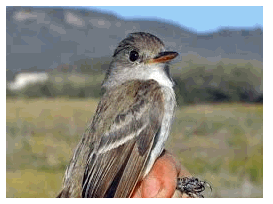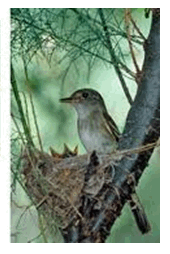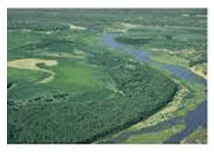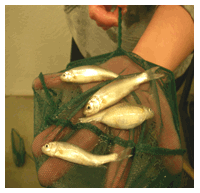Interstate Stream Commission
Threatened and Endangered Species in the Rio Grande Basin
Along the Rio Grande within New Mexico there occur four listed species under the Endangered Species Act, of which, three are endangered (Southwestern willow flycatcher, Rio Grande silvery minnow, and New Mexico meadow jumping mouse) and one is threatened (Western Yellow-Billed Cuckoo). These species must be taken into consideration in current and future water management actions in the Rio Grande. More information on these species can be found on U.S. Fish and Wildlife Service websites.
Southwestern willow flycatcher
 Species Status and Distribution: The Southwestern Willow Flycatcher (Empidonax trailllii extimus/flycatcher) was added to the endangered species list in 1995 and the final rule for critical habitat designation was in 2013 (78 FR 343). The flycatcher range is from Central America, through as the southwestern United States and extends as far north as Colorado and Utah.
Species Status and Distribution: The Southwestern Willow Flycatcher (Empidonax trailllii extimus/flycatcher) was added to the endangered species list in 1995 and the final rule for critical habitat designation was in 2013 (78 FR 343). The flycatcher range is from Central America, through as the southwestern United States and extends as far north as Colorado and Utah.
Species Description: The small (less than 6-inch in length) brownish-olive to gray-green bodied flycatcher with conspicuous light-colored wingbars, whitish throat, and yellowish belly is best identified by its vocalizations.
 Ecology: The Southwestern Willow Flycatcher breeds and rears it chicks in the late spring and through the summer in southwestern states, including New Mexico's dense riparian vegetation along streams, rivers, wetlands. By the end of September, the flycatcher has flown to Central America for the winter. The flycatcher has strong site fidelity, meaning it sets up nesting territories and tends to return to these areas every year. Loss and degradation of dense riparian habitats due primarily to changes in the flow regime are the primary habitat threat to the flycatcher. Human disturbances can result in nest abandonment.
Ecology: The Southwestern Willow Flycatcher breeds and rears it chicks in the late spring and through the summer in southwestern states, including New Mexico's dense riparian vegetation along streams, rivers, wetlands. By the end of September, the flycatcher has flown to Central America for the winter. The flycatcher has strong site fidelity, meaning it sets up nesting territories and tends to return to these areas every year. Loss and degradation of dense riparian habitats due primarily to changes in the flow regime are the primary habitat threat to the flycatcher. Human disturbances can result in nest abandonment.
 The greatest number of flycatcher nesting territories on the Rio Grande is in the delta section of Elephant Butte Reservoir. Numerous agencies and nongovernmental organizations conduct monitoring for the flycatcher during its resident time in New Mexico.
The greatest number of flycatcher nesting territories on the Rio Grande is in the delta section of Elephant Butte Reservoir. Numerous agencies and nongovernmental organizations conduct monitoring for the flycatcher during its resident time in New Mexico.
For more information: U.S. Fish and Wildlife Species Profile – Southwestern Willow Flycatcher
Rio Grande Silvery Minnow
 Species Status and Distribution: The Rio Grande silvery minnow (Hybognathus amarus, silvery minnow) was listed as federally endangered in 1994 (July 20, 1994; 59 FR 36988) and critical habitat was designated in 2003 (February 19, 2003; 68 FR 8087). The U.S. Fish and Wildlife issued the Rio Grande Silvery Minnow Recovery Plan, First Revision in 2010. The species was extirpated from about 93 percent of its historical range, currently persisting in only one 280-kilometer (km) (174-mile (mi)) reach of the Rio Grande River in New Mexico, downstream of Cochiti Dam to the headwaters of Elephant Butte Reservoir. In December 2008, silvery minnows were introduced into the Rio Grande River near Big Bend, Texas, as a nonessential, experimental population under section 10(j) of the ESA (December 8, 2008; 73 FR 74357).
Species Status and Distribution: The Rio Grande silvery minnow (Hybognathus amarus, silvery minnow) was listed as federally endangered in 1994 (July 20, 1994; 59 FR 36988) and critical habitat was designated in 2003 (February 19, 2003; 68 FR 8087). The U.S. Fish and Wildlife issued the Rio Grande Silvery Minnow Recovery Plan, First Revision in 2010. The species was extirpated from about 93 percent of its historical range, currently persisting in only one 280-kilometer (km) (174-mile (mi)) reach of the Rio Grande River in New Mexico, downstream of Cochiti Dam to the headwaters of Elephant Butte Reservoir. In December 2008, silvery minnows were introduced into the Rio Grande River near Big Bend, Texas, as a nonessential, experimental population under section 10(j) of the ESA (December 8, 2008; 73 FR 74357).
Species Description: The Rio Grande silvery minnow is a small, relatively heavy-bodied minnow, round to ovate in cross-section, with moderately small eyes and a small, slightly oblique mouth (Pfleiger 1980). Adults may reach 3.5 inches (89 mm). Live specimens are light greenish-yellow dorsally and light cream to white ventrally. Fins are moderate in length and variable in shape; dorsal and pectoral fins are rounded at tips.
Ecology: Throughout much of its historic range, the decline of the Rio Grande silvery minnow is attributed primarily to destruction and modification of its habitat due to dewatering and diversion of water, water impoundment, and modification of the river (channelization). Competition and predation by introduced non-native species, water quality degradation, and other factors also have contributed to its decline.
Prior to Federal listing, little was known of the life history and ecology of the Rio Grande silvery minnow. Much of the following information is derived from studies undertaken since the mid-1990s. All knowledge of Rio Grande silvery minnow life history and behavior is derived from studies in the middle Rio Grande which represents the remaining seven percent of the range, where substantial habitat loss and degradation has occurred. Prior to the large-scale influence of humans on the watershed, the ecosystem that supported the species was a highly dynamic fluvial system. It is believed that a significant portion of the river was a wide, braided, sand-bedded system with an extensive active floodplain composed of numerous secondary channels, floodplain lakes and marshes, and woody debris.
The Rio Grande River has undergone considerable change in the last 150 years and is no longer the highly dynamic system it once was. Several large dams and irrigation diversions have been built on the river, and the entire system is now operated to reduce flood threats and to supply water for irrigation and municipal and industrial uses. In many areas, channel incision has reduced overbank flow onto the floodplain. Channels have been straightened and deepened and riparian vegetation was routinely removed. These changes have reduced the surface area and physical complexity of the habitat, reduced refugial habitats, prevented upstream movement of fish, and altered species interactions. The quantity and type of sediment entering the river has been reduced primarily due to retention behind dams.
The Rio Grande silvery minnow uses only a small portion of the available aquatic habitat. In general, the species is most often found in areas of low or moderate water velocity (e.g., eddies formed by debris piles, pools, backwaters, and embayments) and is rarely found in habitats with high water velocities, such as main channel runs, which are often deep and swift. The long-term monitoring of silvery minnows has recorded substantial (several orders of magnitude increases and decreases) fluctuations in population abundance. Population size appears to be correlated with hydrologic conditions, particularly the magnitude and duration of the spring runoff. More studies are planned to better understand the life history needs of the silvery minnow by the Middle Rio Grande Endangered Species Collaborative Program.
For more information: U.S. Fish and Wildlife Species Profile – Rio Grande silvery minnow
New Mexican meadow jumping mouse
 Species Status and Distribution: The New Mexico meadow jumping mouse (Zapus hudsonius luteus, jumping mouse) was listed as endangered in July of 2014 (79 FR 33119) and critical habitat designation was published in April 2014 (79 FR 19307). This species is listed wherever it is found, but States/US Territories in which the New Mexico meadow jumping mouse, is known to or is believed to occur in Arizona , Colorado , New Mexico. Along the Middle Rio Grande, the New Mexico meadow jumping mouse is known to occur in the Bosque del Apache National Wildlife Refuge, San Antonio, New Mexico.
Species Status and Distribution: The New Mexico meadow jumping mouse (Zapus hudsonius luteus, jumping mouse) was listed as endangered in July of 2014 (79 FR 33119) and critical habitat designation was published in April 2014 (79 FR 19307). This species is listed wherever it is found, but States/US Territories in which the New Mexico meadow jumping mouse, is known to or is believed to occur in Arizona , Colorado , New Mexico. Along the Middle Rio Grande, the New Mexico meadow jumping mouse is known to occur in the Bosque del Apache National Wildlife Refuge, San Antonio, New Mexico.
Species Description: The jumping mouse is grayish-brown on the back, yellowish-brown on the sides, and white underneath. The species is about 7 to 10 inches in total length, with elongated feet and an extremely long tail (5 inches).
Ecology: The jumping mouse is a habitat specialist. It nests in dry soils, but uses moist, streamside, dense riparian/wetland vegetation up to an elevation of about 8,000 feet. The jumping mouse appears to only utilize two riparian community types: 1) persistent emergent herbaceous wetlands (i.e., beaked sedge and reed canary grass alliances); and 2) scrub-shrub wetlands (i.e., riparian areas along perennial streams that are composed of willows and alders). It especially uses microhabitats of patches or stringers of tall dense sedges on moist soil along the edge of permanent water. Home ranges vary between 0.37 and 2.7 acres and may overlap. The jumping mouse is generally nocturnal, but occasionally diurnal. It is active only during the growing season of the grasses and forbs on which it depends. During the growing season, the jumping mouse accumulates fat reserves by consuming seeds. Preparation for hibernation (weight gain, nest building) seems to be triggered by day length. The jumping mouse hibernates about 9 months out of the year, longer than most other mammals.
For more information: U.S. Fish and Wildlife Species Profile – New Mexico meadow jumping mouse
Western Yellow-Billed Cuckoo
 Species Status and Distribution: The Western Yellow-Billed Cuckoo (Coccyzus americanus occidentalis) was listed as threatened in November 3, 2014 (79 FR 59991) and critical habitat designation is under review (79 FR 67154). The states in which the Western Yellow-Billed Cuckoo is known to or is believed to occur are Arizona, California, Colorado , Montana, Nevada, New Mexico, Oregon, Texas, Utah, Washington, and Wyoming.
Species Status and Distribution: The Western Yellow-Billed Cuckoo (Coccyzus americanus occidentalis) was listed as threatened in November 3, 2014 (79 FR 59991) and critical habitat designation is under review (79 FR 67154). The states in which the Western Yellow-Billed Cuckoo is known to or is believed to occur are Arizona, California, Colorado , Montana, Nevada, New Mexico, Oregon, Texas, Utah, Washington, and Wyoming.
Species Description: The Western Yellow-Billed Cuckoo is about 12 inches in length. It is brownish above and white below; with rusty colored flight feathers. The upper mandible of the bill is black and the lower mandible is yellow. The underside of the tail has pairs of large white spots.
Ecology: The western yellow-billed cuckoo is a shy neotropical migrant bird; its loud “ka, ka, ka, ka, ka, kow, kow, kow” call is often the only evidence that this reclusive bird is present. Traveling from their winter homes in South America, the birds arrive in the Western United States to breed from early June to late August in vegetated areas along rivers and streams. Once common between the Rocky Mountains and the Pacific Ocean and from lower British Columbia, Canada, south to northern Mexico, western cuckoos have now disappeared from the Pacific Northwest and Canada, and only a few pairs still breed in Utah, Idaho, Colorado, and Nevada. Most breeding occurs in isolated areas along rivers in Arizona, California, and New Mexico. Cuckoos prefer breeding habitat dominated by native tree species, especially cottonwood-willow habitat.
For more information: U.S. Fish and Wildlife Species Profile – Western Yellow-Billed Cuckoo
